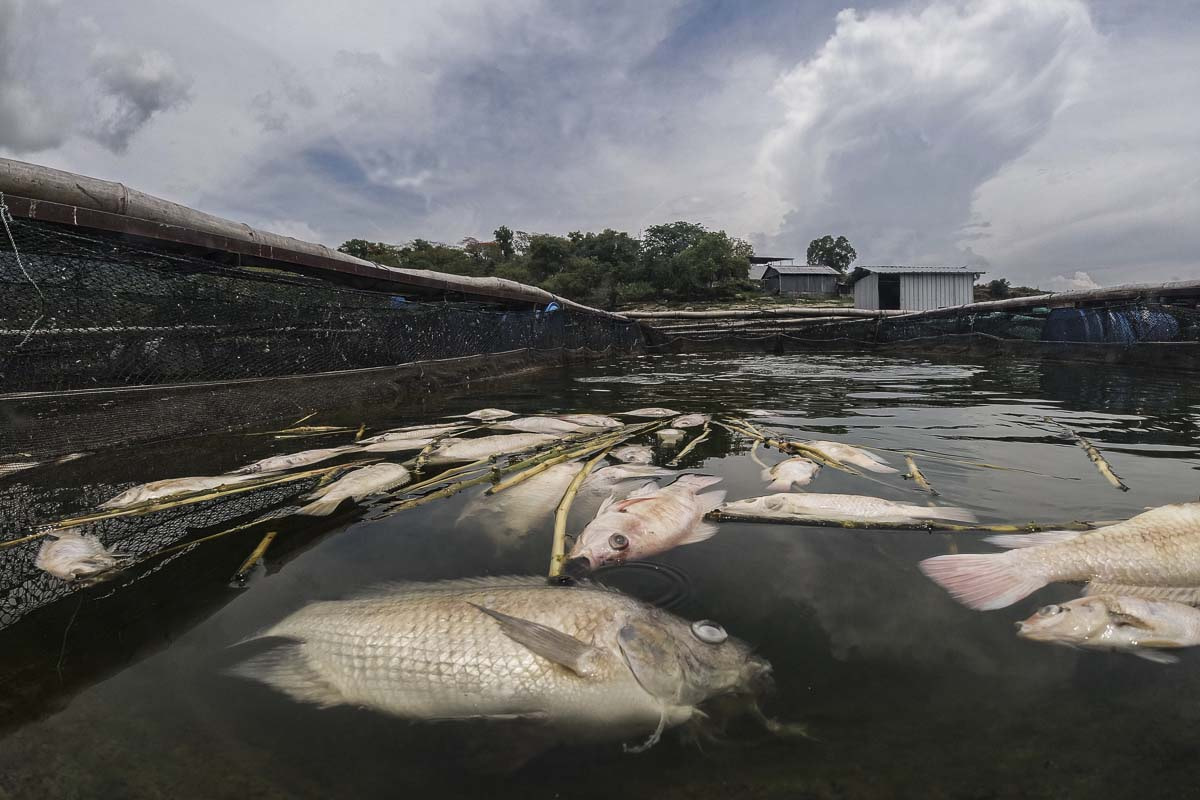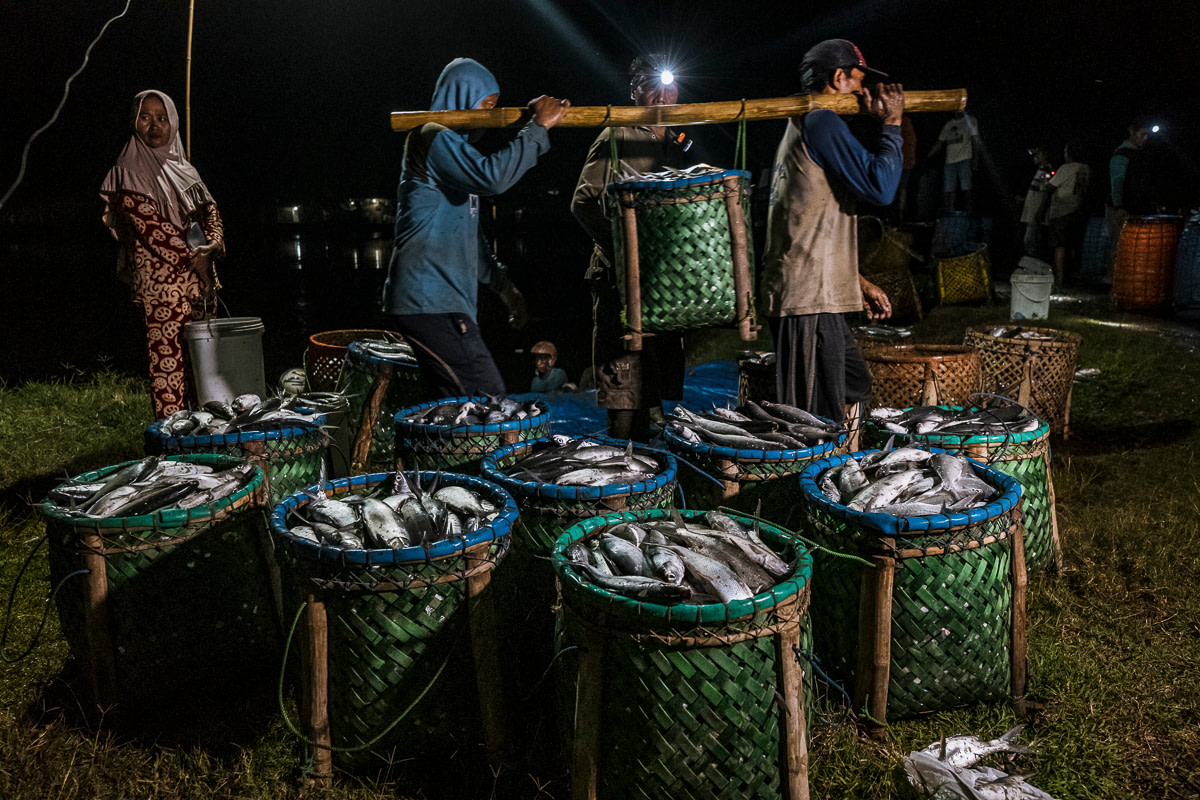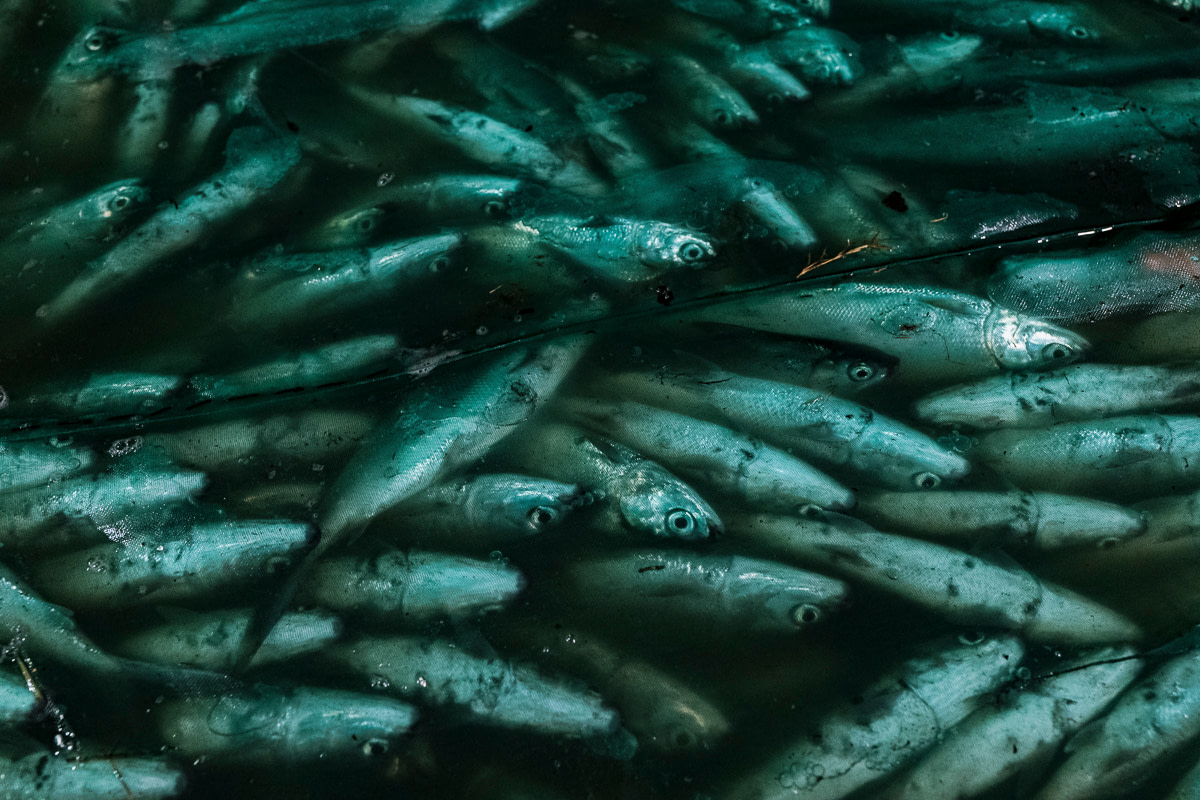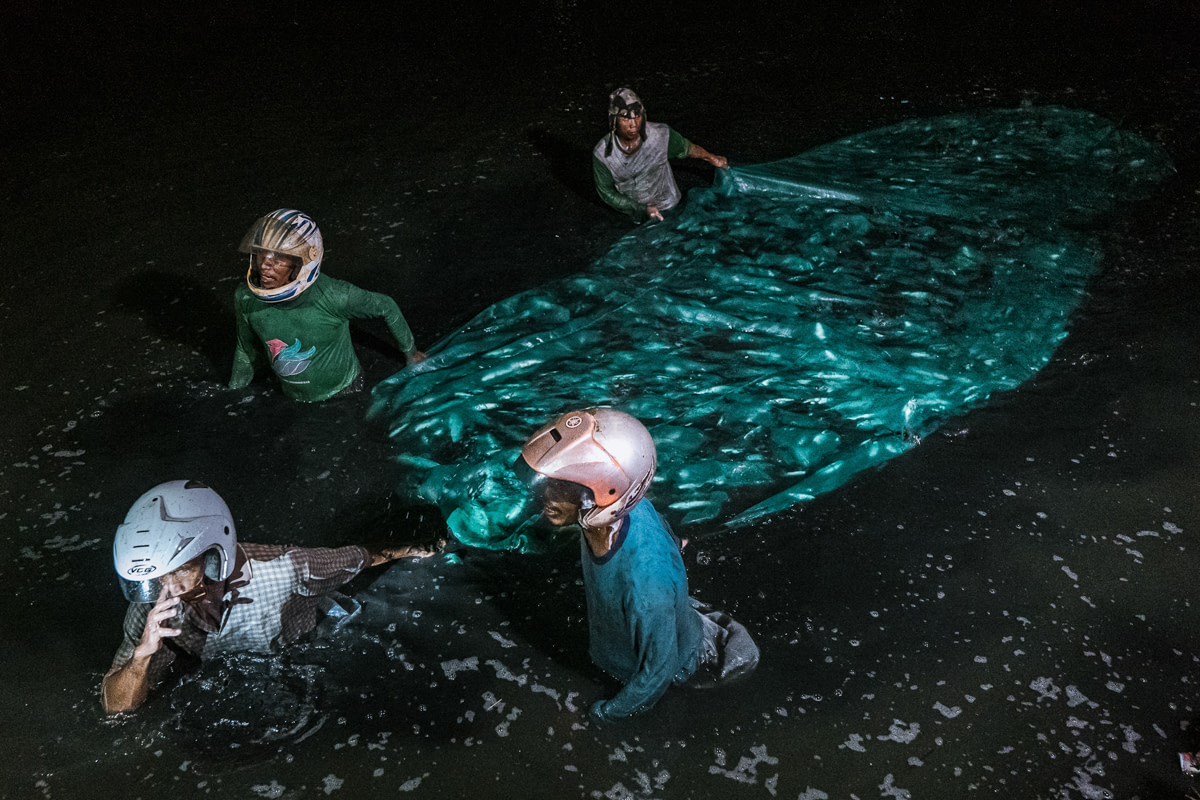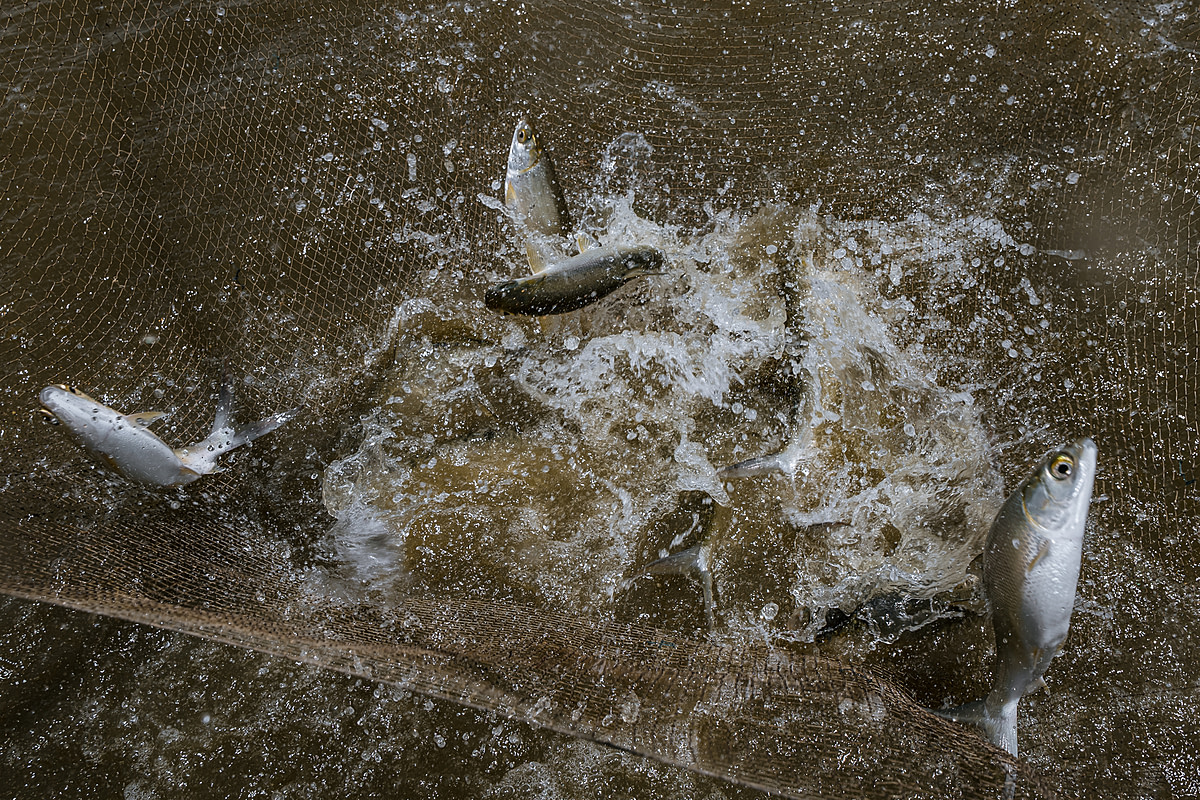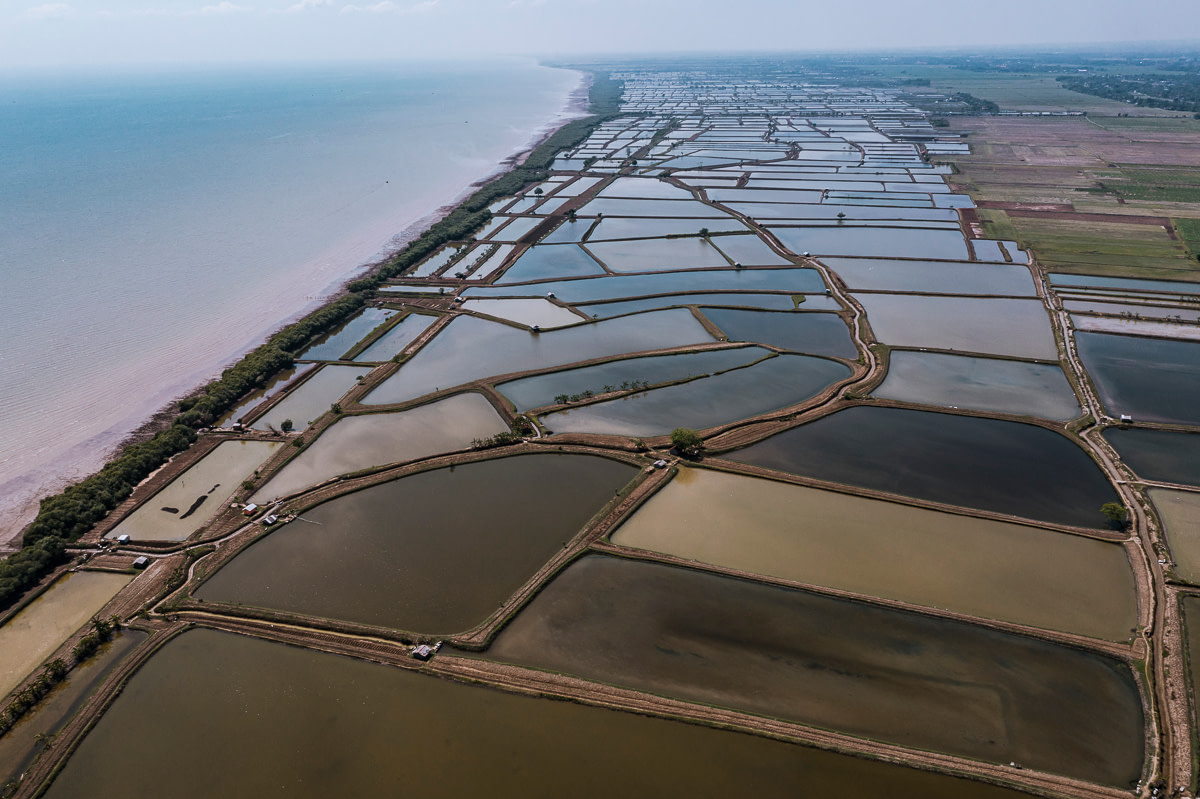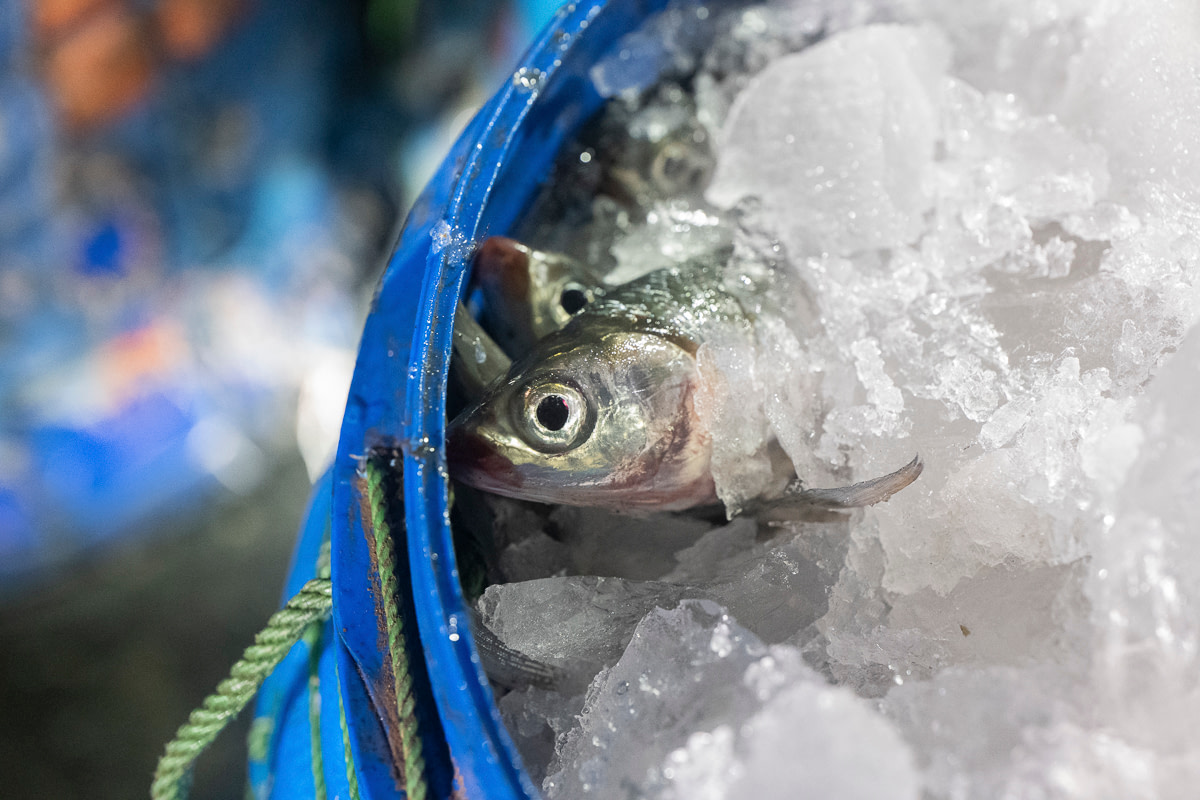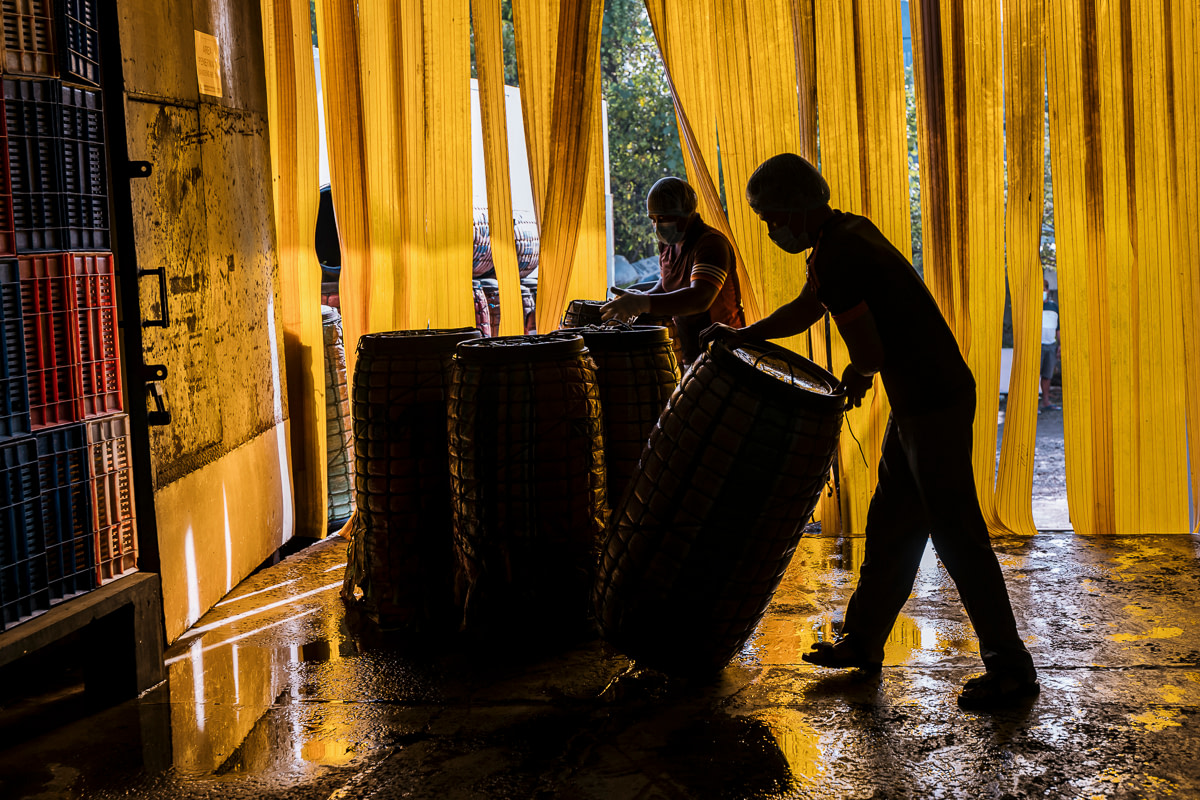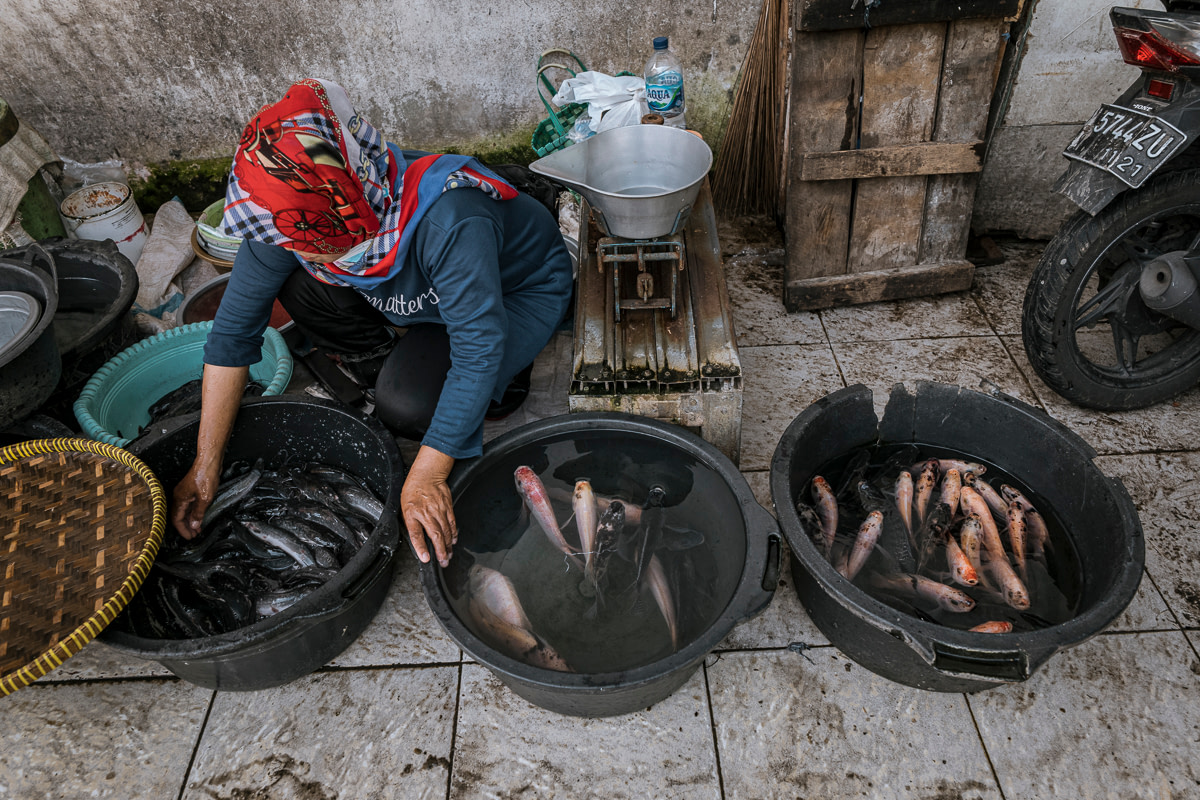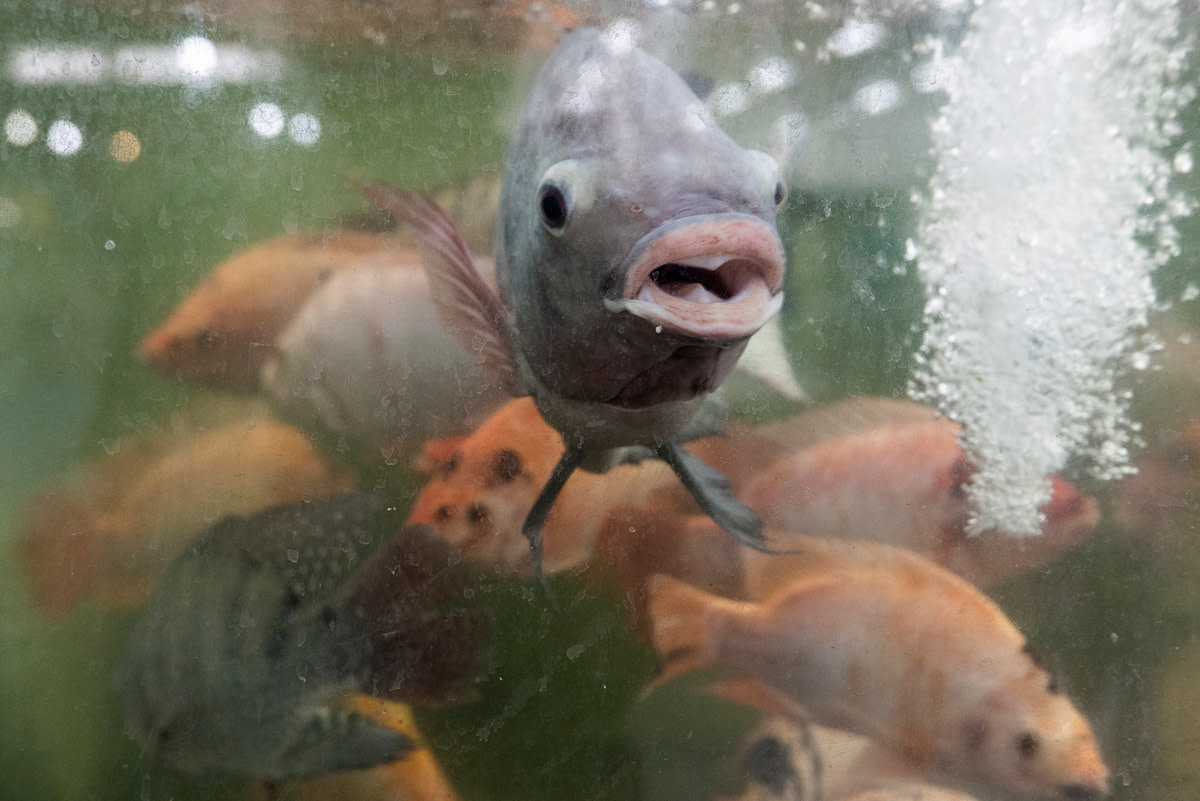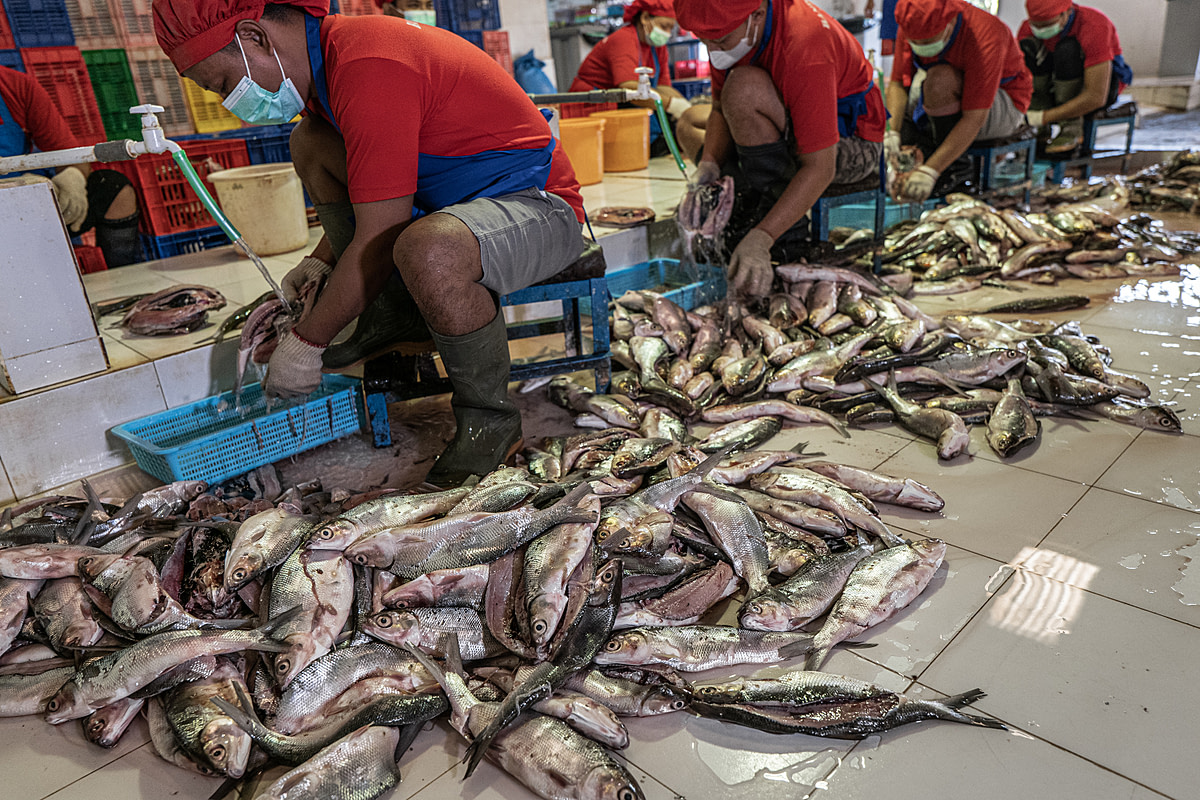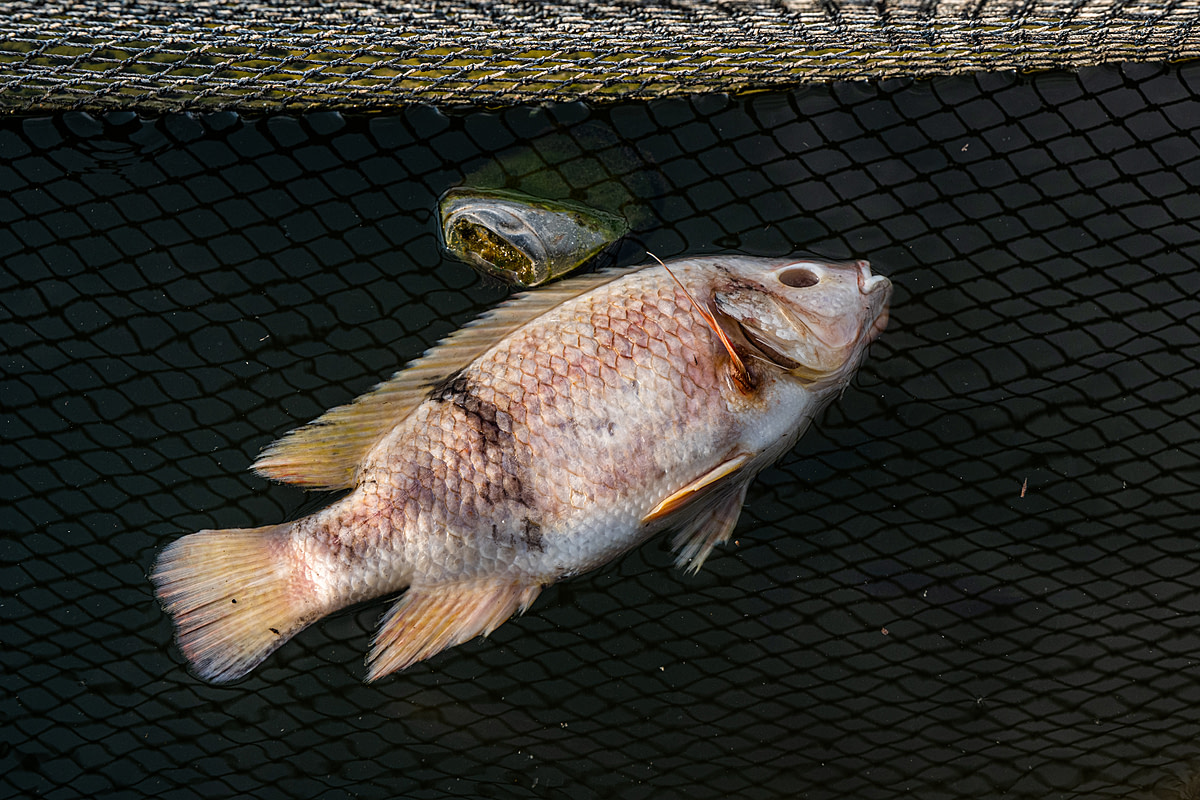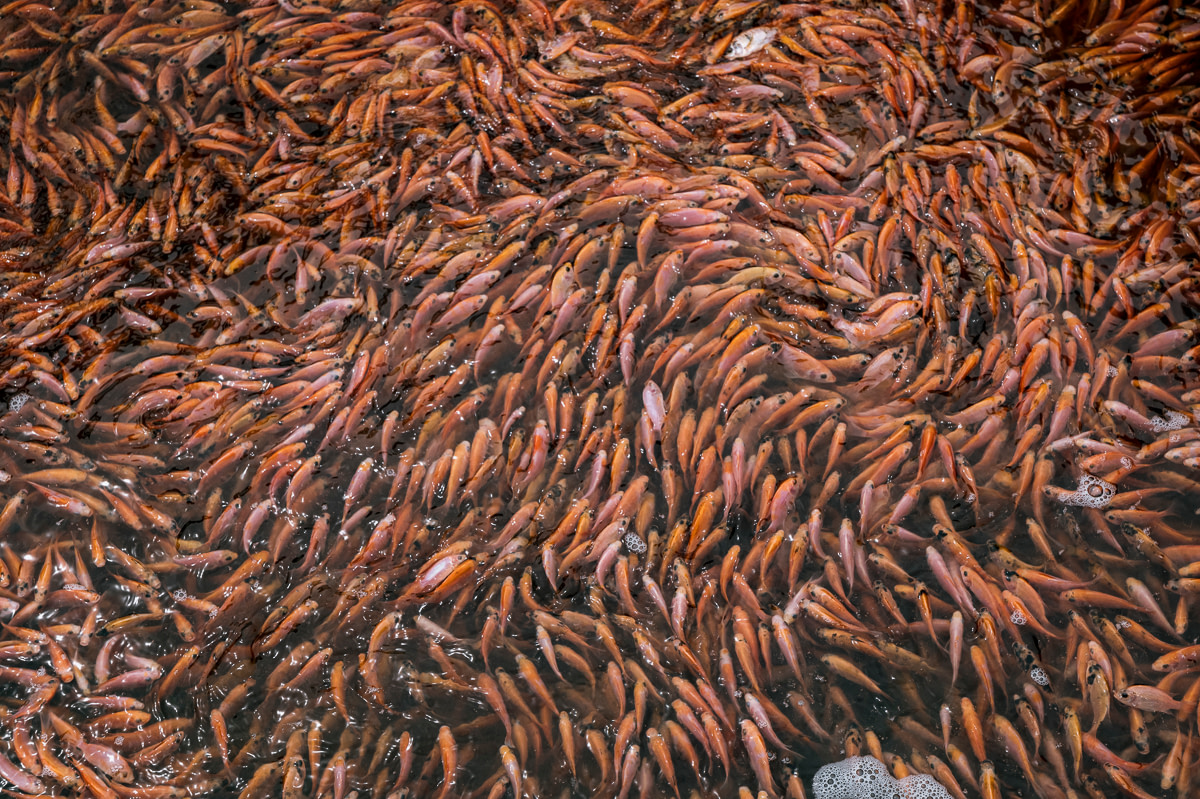A close-up view of the white and decaying bodies of several dead tilapia floating on the surface of a floating cage at an Indonesian fish farm. Indonesia, 2021.
Lilly Agustina / Act for Farmed Animals / We Animals
[Content warning: Contains confronting images and/or video footage]
An investigation conducted by Act For Farmed Animals and We Animals has revealed for the first time how tilapia, catfish and milkfish are farmed, killed and sold in Indonesia.
Act for Farmed Animals is demanding producers and retailers to improve the treatment of these farmed fish.
Photographer: Lilly Agustina
Videographer: Kasan Woles
In collaboration with: Act for Farmed Animals
Fish are sensitive, intelligent animals with complex behaviors. They can learn from each other, recognize other fish, remember solutions to problems for most of their lives and can even use tools. But despite their sensitivities and intelligence our exposé shows:
- Unsanitary conditions, with fish visibly sick and dying prematurely, left to float in their pens once dead.
- Live fish transported on ice, a practice decried by animal welfare specialists.
- Fish skinned and cut open while still fully conscious at local markets and farms.
- And alarming environmental impacts to surrounding areas.
“We are inviting Indonesian consumers to help change this reality. We must be more aware of how detrimental to sanitation, the environment and animal welfare the current practice of farming fish is, and take concrete action to solve these issues.” — Act for Farmed Animals
At the Fish Farms and Hatcheries
The so-called harvesting of milkfish is a daily occurrence in Central Java, Indonesia and typically takes place at night. At various farms in this region, our investigators documented milkfish living in visibly dirty water, with low oxygen levels. Some fish were suffering from exhaustion, sickness and premature death, while others showed signs of disease from poor sanitation and dead fish were left floating in pens.
During a nighttime harvest on a fish farm in Indonesia, workers carry a basket full of dead milkfish to be loaded on trucks and sent to market. Several more baskets full of fish wait in the foreground to be moved. Indonesia, 2021.
Lilly Agustina / Act for Farmed Animals / We Animals
The process requires farm workers to manually net and remove the fish from ponds once they have reached market size (20-40 centimetres in length). To capture the milkfish, workers gradually enclose them by pulling a net across each pond until they cannot escape. This process is chaotic and workers wear protective helmets to avoid injury from the jumping and thrashing fish attempting to flee from the capture. On one farm, an estimated 3.5 metric tons of milkfish from just one pond were confined in nets, and our investigators observed fish dying during the process.
During a nighttime harvest at an Indonesian fish farm, workers wearing protective helmets wade through the water of a fish pond while pulling a mesh harvesting net tightly packed with captured milkfish. Crowding the fish together deprives them of oxygen and they will eventually suffocate. Indonesia, 2021.
Lilly Agustina / Act for Farmed Animals / We Animals
Like other types of fish reared in the aquaculture industry, farmed milkfish are usually fed a diet consisting primarily of food pellets. Despite being a herbivorous species, some farms will add supplements using such ingredients as rice bran, corn, rejected snack foods, snail meat, or chicken entrails, among others.
Our investigators also visited a milkfish hatchery that was part of a larger milkfish rearing farm, spread over several hectares and containing numerous ponds. Despite being kept in separate areas before being transferred to other ponds, where they are fed intensively until they reach market size, only about 40 to 50 percent of these baby fish will survive this stage of their lives.
At the Food Market and Retailers
Indonesia’s traditional markets typically open around 9 p.m., so the fish are harvested at night when cooler temperatures help to keep the dead fish fresh for sale. Once removed from the water, the fish are transported on ice, destined for auction or directly to large grocery stores and small traditional markets.
The ice is not considered a slaughter or stunning method, but many fish die from lack of oxygen on route, while still conscious. Scientific studies have concluded that ice causes thermal shock, and it is a painful and stressful process that keeps fish conscious and sensitive to pain for prolonged periods.
Close-up view of a dead milkfish, from the evening’s harvest, packed in ice inside a transportation barrel and waiting to be sent to market on a fish farm. Indonesia, 2021.
Lilly Agustina / Act for Farmed Animals / We Animals
At one small and busy market, three different vendors were seen selling catfish, pangasius, tilapia, carp, and gourami. Some of the fish in the displays at this market were still breathing, having survived transport, in part due to thermal shock. Our investigators also witnessed fish being skinned and cut open while still fully conscious.
Dead and dying tilapia lie on a display table with no water at a fish market in Indonesia. One fish jumps and squirms in distress. Indonesia, 2021.
Kasan Woles / Act for Farmed Animals / We Animals
In one food and consumer goods market, carp, gourami, pangasius, tilapia, catfish, and other aquatic animals were available for purchase and slaughtered on-site. Fish were observed being held in crowded barrels before being killed and processed, without water and with no oxygenation or temperature control. In the case of catfish, a species known to have robust physiology and capable of temporary survival out of water, the animals were observed struggling and possibly still alive while their bodies were being cut apart.
Live catfish heaped inside a small tub are sorted for size by a fishmonger at a small Indonesian food market. While the tub in which the catfish are held contains no water, the robust physiology of catfish allows them to stay alive outside of water longer Indonesia, 2021.
Lilly Agustina / Act for Farmed Animals / We Animals
Indonesian retailers still keep fish alive in tiny tanks in their stores, where fish can barely swim and may suffer from pain, fear and stress. At one of Indonesia’s largest supermarket retailers, fish are sold live, recently killed, frozen, or as prepared products such as fish “meatballs.” Live fish including tilapia, gourami, and catfish were observed crowded in tanks in stressful conditions.
At the Fish Slaughterhouses
At a fish slaughterhouse in the Central Java region, we documented tilapia, catfish, and gourami being unloaded with dip nets and transferred to small holding ponds containing dark and dirty water. Fish were crowded, with little space to move. The slaughterhouse workers chose each fish for slaughter with their bare hands. Rejected fish were thrown back into the ponds, and selected animals were put into plastic baskets that contained no water.
A row of workers at an Indonesian milkfish warehouse pick up the dead bodies of milkfish from piles on the floor in order to clean them by removing each fish’s gills by hand, then rinsing each fish in running water. Indonesia, 2021.
Lilly Agustina / Act for Farmed Animals / We Animals
During slaughter, workers placed fish on an unsanitary table and used sticks to hit them on the head before removing their gills and entrails. Often the fish were still conscious and able to feel pain or gasp for air as they lay on the table waiting to be killed and processed.
Once butchered, the fish were bagged in plastic and sold to retail market sellers, restaurants, and individual buyers.
A worker at a fish slaughterhouse in Indonesia uses a wooden stick to strike live tilapia on the head and kill them, but the technique is not exact so not all the fish die. Workers will next remove the gills, entrails and scales to prepare the fish for sale. Indonesia, 2021.
Kasan Woles / Act for Farmed Animals / We Animals
Environmental Concerns
In August 2018, at Kedung Ombo Reservoir, over 100 tons of farmed tilapia died. Experts say the large number of floating nets in the dam and quantity of food given to fish has led to a rise in bacteria, toxins and water pollution. This problem is an ongoing issue, with instances of farmed fish found dead a common occurrence.
Overhead view of the decaying body of a dead tilapia floating on the surface water of a net cage. The cage is inside an Indonesian fish farm that is located on a freshwater reservoir. Indonesia, 2021.
Lilly Agustina / Act for Farmed Animals / We Animals
Kedung Ombo is a massive reservoir located in the Central Java Province of Indonesia and is one of the country’s major freshwater reservoirs. The reservoir supplies drinking water, power generation, flood control, fishing, and fish cultivation using floating net cages. Aerial views reveal numerous fish farms in the reservoir, rearing primarily tilapia, carp, and pangasius.
Aerial view of a freshwater reservoir containing multiple Indonesian fish farms and the hundreds of floating cage pens where fish are kept. Indonesia, 2021.
Kasan Woles / Act for Farmed Animals / We Animals
“Unfortunately, fish are often dismissed as ‘less of an animal,’ as people tend to think that they are not intelligent or sensitive enough. Farmers and retailers in Indonesia can adopt better measures recommended by fish welfare experts.” — Act for Farmed Animals












Indonesia, 2021.
Lilly Agustina / Act for Farmed Animals / We Animals
Fish are sensitive, intelligent animals who are subjected to stressful and painful conditions at fish farms, markets and retailers in Indonesia. At every step of the process we documented poor animal welfare conditions, some of which would be agonizing for the fish. This, in tandem with environmental pollution, creates a strong case for change.
We invite readers to explore Act for Farmed Animals’ campaign. Learn how you can take action at www.actforfarmedanimals.org/ikan.
Photographer: Lilly Agustina
Videographer: Kasan Woles
In collaboration with: Act for Farmed Animals
To view more images and video from this collection, visit our Indonesia Fish Farming gallery.

